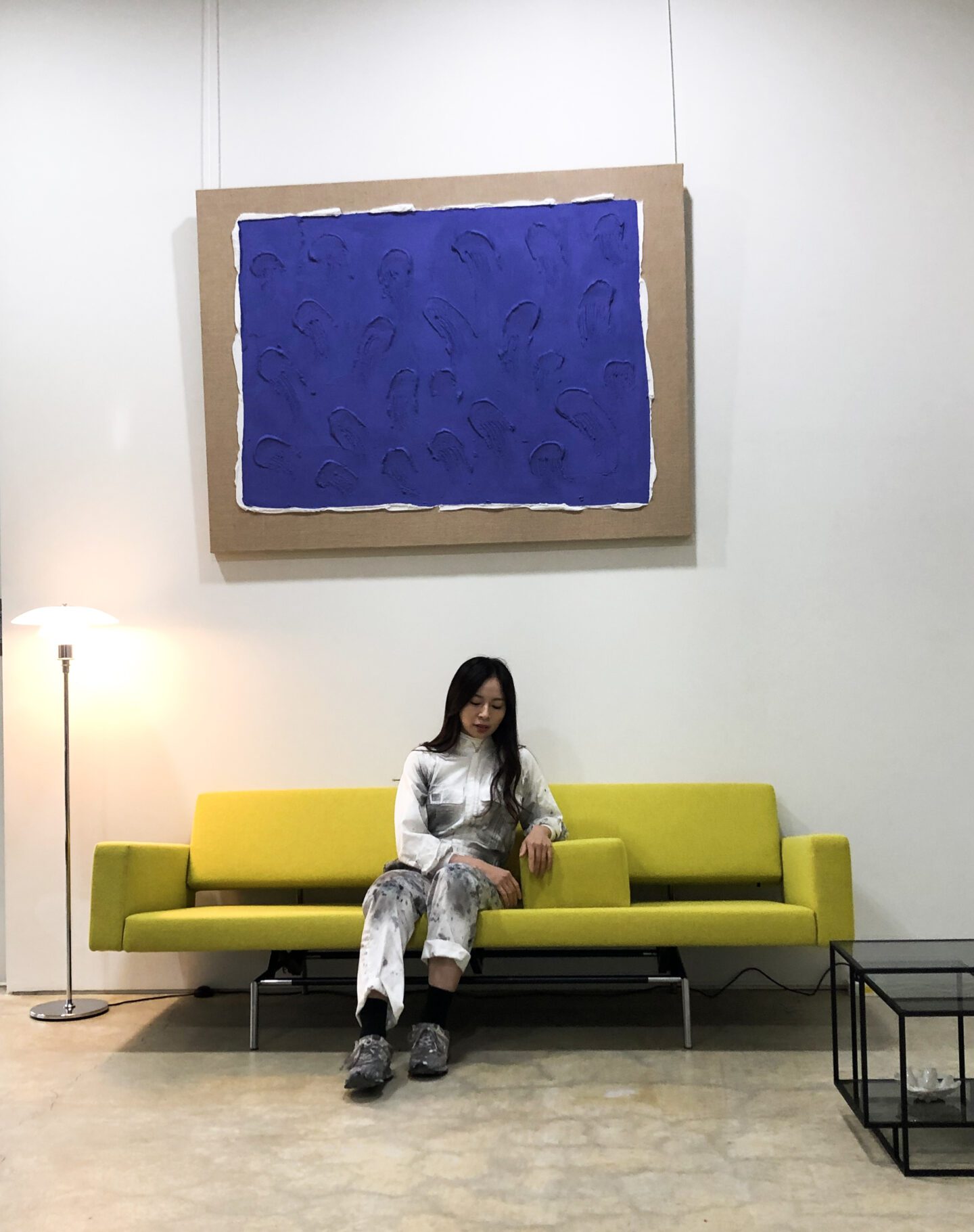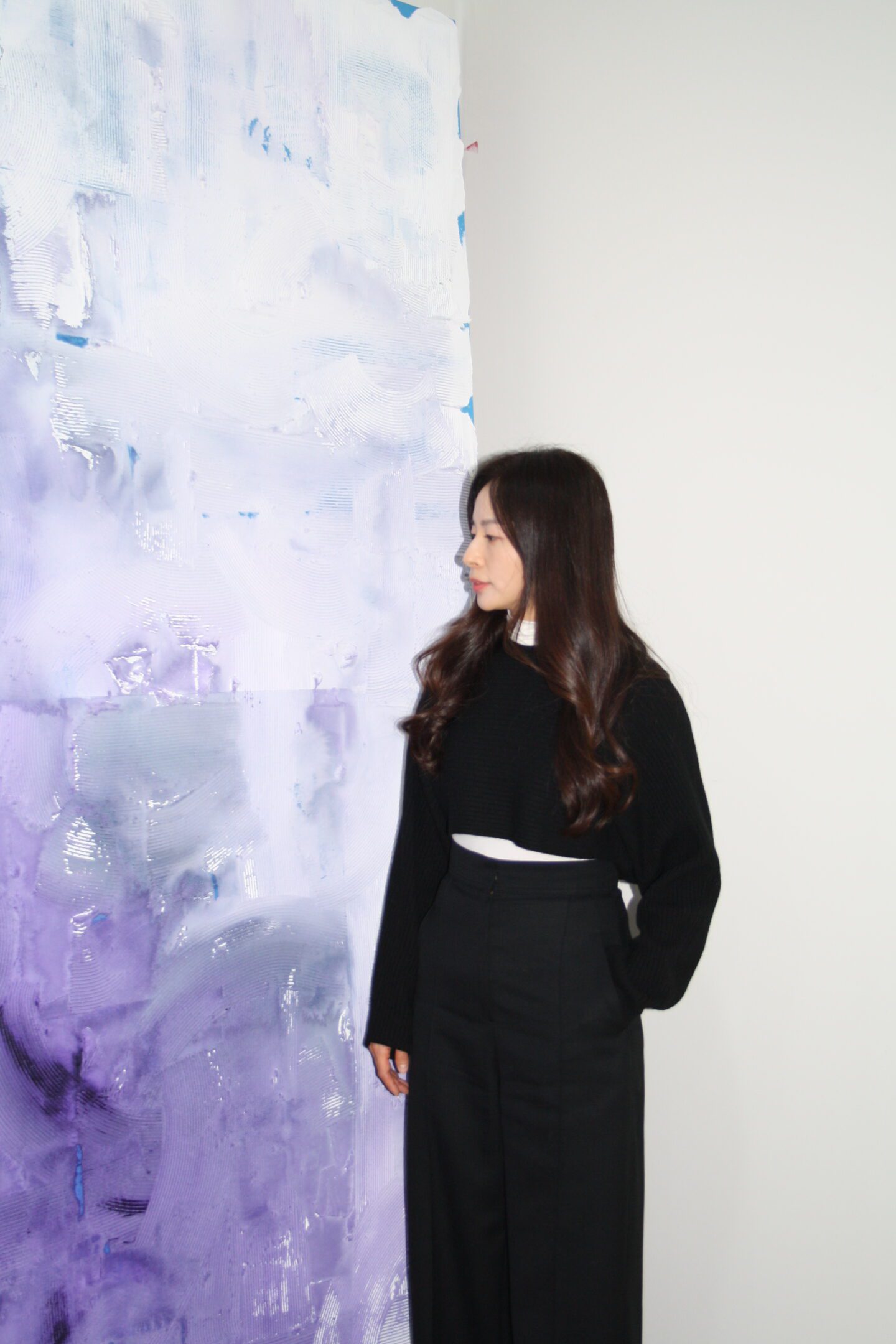Maria Chang: Taking Over the Korean Art Market with a Silent Abstraction

Maria Chang is one rising female Korean artist that you need to know. Her art explores thick materical work on canvas, endlessly researching on new subjects and materials to explore different languages in her practice. Her journey through finding her artistic identity – which is parallel to her quest on her own personal identity – is in constant evolution. The artist’s process is closely personal, and this reflects in her choice of color and her approach to her paintings as created through “re-birth out of destruction”.
Feeling always “in-between” she investigates her own dichotomous approach to life, herself and her identity through art – which, for the artist – is created out of “trying to repair a deficiency”. Dictated by close personal experiences and by a constant need of creation in order to express herself and her emotions as a symbol of honesty, Maria’s unique style evolved from figurative, to nonspecific figuration, and – ultimately – to abstractism.
Seeing her role as a painter as a “medium” for creativity to be expressed on canvas, Chang enjoys painting with music and does not consider a work completed until she experiences a “silent moment.” Born from a religious family, and daughter of a theologist, her religious background plays an important role for her, but is negotiated with all the other influences and life experiences.
To understand her art, we need then to understand her personal complexity, and – as women, and human beings – this endless quest towards ourselves is a highly relatable thing: her colorful and textural abstract work, which is both calming and moving at the same, has the power of connecting to us brightly and deeply.
Chang has been recently nominated one of the hottest Korean artists, and she also recently gained her auction record at Seoul Auction winter sales: we sat down with her at her studio in Seoul and chatted about how 2021 was for her, about her philosophy, her dreams for the future and, most importantly, her art.

How did you decide to become an artist, what does art mean for you?
For me art is born out of a “deficiency”, so it means repairing the deficiency that I feel. I think that experiences from my young childhood led me to become an artist: My parents always bought me and my sisters big paper sheets to draw and be creative. Since childhood, I was always drawing something or making something.
You started with a series of figurative paintings and slowly proceeded into abstraction, how was that evolution for you?
When I was doing figurative paintings and self-portraits, everything was all about me, thinking about myself and trying to show how I feel and who I am. In that process, the self-portrait “grey is the new black” series began after I lost my right eyesight, and I was showing how my face-figure would come out after this event. However then, through time, I think I healed and started thinking more about the relationship “you vs. I” both within myself and with people who influence me, and that kind of led me to abstract painting…and the relationship with abstract painting came out throughout the development of how I would paint lines, which would come off stronger and stronger with time.
What role does color play in your art?
Actually the relationship with color is personal for me and linked to my own life experiences. For instance, when I was in college my paintings were very colorful and bright, and after I went to Africa – precisely Kenya and Ethiopia – I was inspired in creating even more colorful works. But then, after I lost my right eyesight, I covered all the colors with grey, through a blurry technique showing what I felt (dark, blurry, unknown color) and I scratched with sharp things, and underneath there were still colors emerging, so it was as if I wanted to show myself but I wasn’t really ready. Then, 3 or 4 years ago it was spring – and, you know, here there is a strong cherry blossom culture – I was so inspired by that season and I started painting colors again… I started a lonely process of searching within myself for color, and it finally came out in the “Spring Series”. I think I was finally over with the sadness. Color for me is myself, but also a healing and re-building process.
Could you tell us about your artistic process and research?
Actually I get a lot of ideas out of destroying things: when I make something pretty and I start to destroy it, and I do something new out of it, and that’s the main process for me in approaching the work. I could say my work is a continuous process of destroying and rebuilding. Philosophically, I believe it is the artwork that chooses me and not vice versa. When I paint – often with music – there is a point when I don’t hear anything anymore and that’s when I feel that the work is finished. Until this “silent moment” happens, I don’t consider the work finished. I also believe that there must be some connection with something beyond me, I don’t know how to define this, but I believe other abstract painters feel the same as me. As I am a Christian, this is part of me and it relates to this process, so part of the process begins with morning prayers, and there’s a link to religion in my paintings.
Technique-wise, it is about destroying and finding new art from destroying pieces, and scratching with sandpaper to create unique things.

What are your major inspirations and influences?
The biggest theme in my artworks is my effort to balance myself between things, and that is why I have these “In-between” series. I constantly try to balance myself. I come from a family with a strong Christian faith but I also admire philosophers such as Descartes. Therefore, I try to balance myself in-between religion and philosophy. Balance is an ongoing theme throughout various aspects of my life, and that is what I try to obtain in regards to existential issues and my own identity as well. I grew up in both Korea and the US and have constantly strived to find a middle ground in this continuing dichotomy, it’s a constant journey! I am also greatly inspired by people around me.
Is there any woman artist you look up to for your work?
I think the woman artist I am most into is Louise Bourgeois, as I think she is also talking about deficiency and healing bad memories. I believe that a lot of women artists are talking about their emotions and feelings, and I had a constant love/hate relationship towards that approach. But I think we can’t hide them, our feelings. I love her work for this, and the way she lived her life, too.
What is your favorite piece in the studio and why?
I guess that large-scale purple one in the corner, but also all the other ones in progress. I love the pieces which are still in progress, they stimulate me to think how they will evolve…
What are you currently working on?
I am working on a new series in which I try to go beyond and outside the frame…it’s again something about finding myself and being more free, they will be exhibited in my future show!

You have been recently nominated among the “hot artists” in Korea, and you also had your auction record recently, which seems like a great achievement! How was 2021 for you?
This year has been a very exciting year and I enjoyed it because I can communicate more about my work, which has gained more exposure. Also, the auction record was a big surprise. Right now, I am just trying to simply enjoy the present and concentrate on my work.
What are you looking forward the most for your future?
I’am planning something in Paris, can’t say more now but, if everything goes well it will be exciting!
What’s exciting about conducting your artistic career in Korea?
I like how people in certain ways have this honesty, which they use as a principle to conduct their life and work. I really like this trait about Koreans.
How would you define being a woman artist in Korea?
Thanks for this question, this is an important issue. Not many female artists are represented in art fairs or auction houses compared to their male counterparts. However, I believe this is changing and now we are seeing more female artists like me in Korea.
Last question, three dream places you would love your art to be seen in?
I really love New York, it’s like my dream place, and so I would say…Gagosian, Guggenheim and MoMa….!



